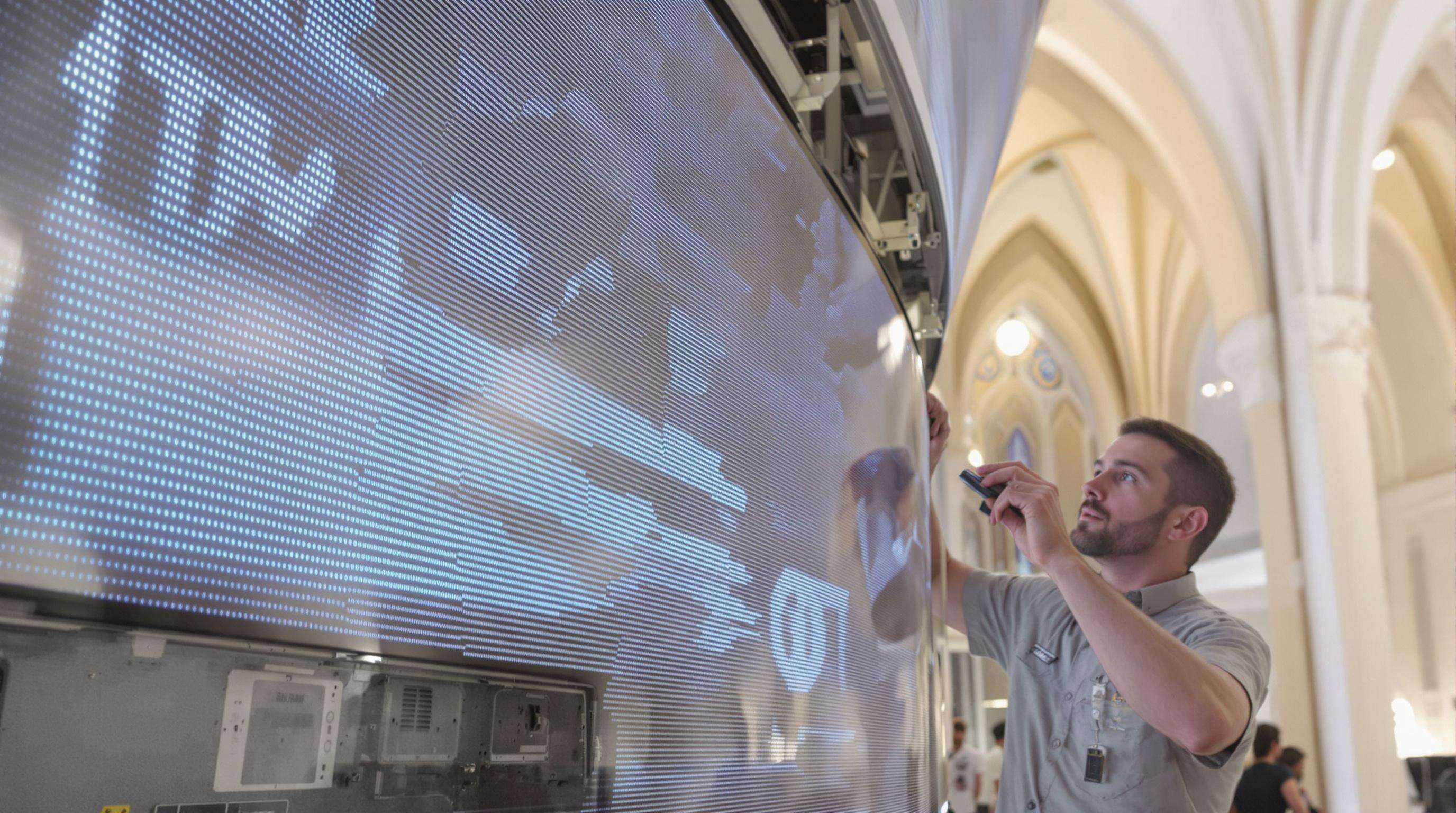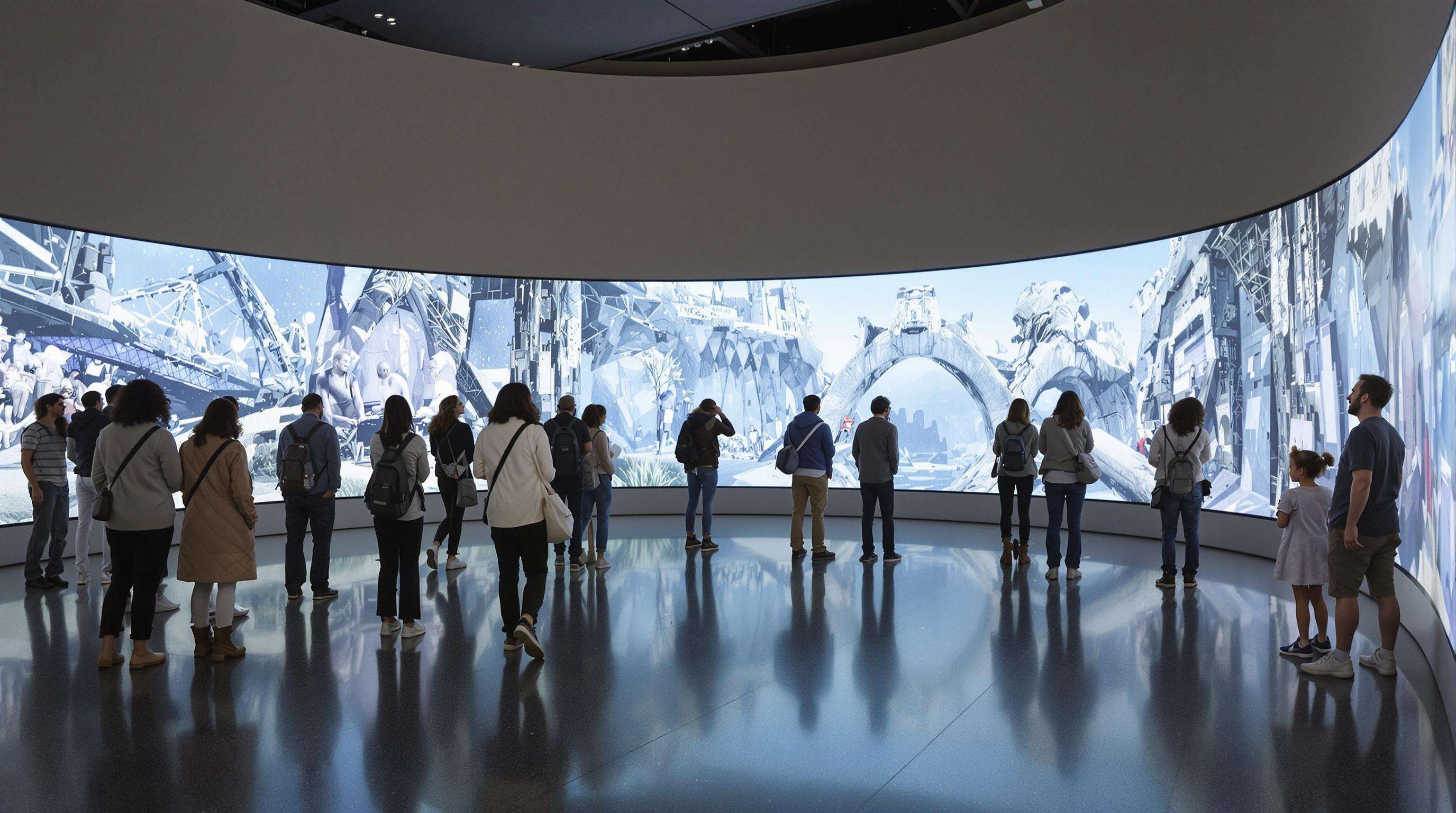Thanks to curved indoor LED screens, museums are no longer a static place to store artefacts – they are where the story comes alive. This hiking route leads you to two exceptional places with large 360° theatrical installations that take you on a mythical journey through history – creating stories of the past. Studies have found that curved exhibitry is effective as well, raising the average visitors’ time spent by 72% over straightline exhibitry and making for a more powerful educational experience (Museum Tech Journal 2023).
The organic contours seamlessly adapt to architectural features like rotundas or vaulted ceilings, eliminating jarring transitions between physical and digital elements. This spatial harmony preserves historical buildings' integrity while enabling unprecedented creative expressionâlike wrapping van Goghâs Starry Night around pillars or projecting ancient civilizations across curved dioramas.
Unlike flat panels, curved screens work in concert with our peripatural vision, so they actually grow your sense of presence. Visitors don’t just look at Titanic’s remains; they are enveloped within a 270° deep-sea simulation as schools of fish flit by hydraulic joints. The technologyâs dynamic-content capabilities also mean that museums can rotate exhibits digitallyâditching Renaissance galleries in favor of quantum physics visualizations in a matter of hours.
While traditional lighting consumes 58% of exhibit energy budgets, modern LED screens reduce this by 40% via integrated low-power modes (Green Museums Initiative 2023), aligning sustainability with cutting-edge storytelling.

Successful museum installations depend on specialized engineering principles that enable dynamic visual storytelling while meeting conservation requirements. Displays must maintain structural integrity across curvilinear forms while delivering pixel-perfect imageryâno easy feat when bending rigid electronic components.
Exact curved radii are essential to undistorted panoramic vision. Unlike bent flat panels in which there is no compensation for angular distortion, true curved displays have consistent pixel density by virtue of geodesic alignment algorithms that calculate the position of pixels in the frame so that an image appears to be on a true curve surface. The sweet spot falls between 4000â6000R curvature steep enough for a sense of immersion, but not so severe that it distorts peripheral visuals when spectators enter installations. This is because a 1,000 sq ft. ft. gallery simply requires a different geometry than a rotunda.
Balancing number of pixels with viewing distances eliminates visible seams in curve installations. 1.2â1.5mm pitches provide sharp images, but can be viewed from a distance of several inches away for any signs of artifacts, while custom microLED arrays sub 0.9mm pitches can blend in closely without any visible seams at any distance. Importantly, the processors correct for optical compression of the pixels on a concave surface by dynamically remapping the pixel loadsâwithout this; Leonardo's sfumato manipulation would appear “pixilated” along curves.
The flat panel needs to have no curvature, i.e., with stress-tested flexible PCB panel segments and redundant soldered joints to avoid damage by micro fractures during thermal expansion. Fluid assemblies: interlocking components with ±0.1mm tolerance by asymmetric pressure point. Sophisticated cooling systems avoid hotspots where air downstream of the curved path is restricted by the bendsâcritical for the room preservation of light-sensitive specimens kept in <50 lux ambient light.
{{< figure src="/engineering/flexible-panel-cooling-system.jpg" alt="Thermal imaging showing uniform heat dispersion across curved LED joints" caption="Optimized thermal management maintains panel integrity at 30° bends" class="mt-5 mb-4" >}}
Museums are able to recreate lost cities and scenes of history on curved LED walls like never before. Modern curved take floorplans to 165°, as the latest displays bring new life to ancient battlefields or past architectural icons, wrapping visitors in 8K historical footage delivered using spatial audio. Installations using curved LED technology increased on-site visitor engagement by 63% over traditional dioramas, according to a 2023 study by the International Council of Museums. These interactive scenes enable a museum to exhibit several chronological strata at once, via interactive touch interfaces.
Top science centers use curved LED walls to depict complex phenomena from celestial mechanics to molecular bonds. The 3800R curvature radius honors the way your eyes receive peripheral vision, so that your visual pleasure is not lost on the large screen, making the game film and video more exciting to see spinning simulation of the galaxy or the flashes of the DNA chain animation more immediate. Newer setups come with motion detectors, visitors can waggle as they navigate a projected 3D hurricane, or the movements of tectonic plates. According to research in the ACM Digital Library (2022), these interactive curved displays increase knowledge retention by 41% in science exhibitions like STEM, compared to static panels.
Artists in the modern era employ curved LED arrays as a tool to question predicated notions of space, generating flowing digital murals affected by architectural forms. Unlike flat screens, 6mm-pitch curved modules can negotiate transitions between concave and convex display areas smoothly, which makes it ideal for showcasing generative art data driven by crowd density or environmental noise. After replacing linear timelines with curved LED art walls in their 2024 âTech and Timeâ exhibit, the Natural History Museum of Vienna saw social media mentions surge 78%, while visitors spent 22% more time immersed in these kinetic installations.
Color-accuracy tolerances lower than ÎE<3 are in demand in museums in order to stay true to an artist's intent in different era and with different media. State-of-the-art LED systems now boast 98% DCI-P3 coverage via 16-bit processing that supports the transitions from Renaissance oil reprints to neon-colored contemporary pieces. For 40 percent higher visitor satisfaction with colour viewing, installations working with these standards became the only thing to previously have been tested (in 2023) by the Cultural Heritage Display Initiative. Calibration routines also account for effects of ambient light, adjusting screen brightness from 150-600 nits to ensure best visibility without loss of pigmentation or over-expenditure of energy.
State-of-the-art exhibits combine 8K LED images with spatial audio (up to 128-channel systems) and haptic feedback zones to develop cohesive sensory narratives. Volcano eruption simulations for instance are combining 240Hz refresh rates and subfloor-stimulating vibration modules clocked by the millisecond. An analysis of 12 major museums in 2022 found that synchronized installations led to an average 30-second increase in dwell time compared with static displays. Today’s platforms even apply AI to adjust multi-sensory output according to real-time crowd densityâdimming ambient sounds during peak hours, for example, or boosting visual contrast for back-row viewers.

Indoor curved LED displays significantly strengthen the rate of museum visitor dwell times. "Those placing films with those displays say visitors spend 40-75% more time dweling at thanks to traditional exhibits, according to delson's anonymized tracking data collected from cultural institutions. Wraparound viewing affects psychological immersion to reduce distraction and increase narrative engagement. Motion-sensor technology has shown that museum goers read 92% of interactive and moving digital stories versus 67% of static pieces of information. Longer engagement is directly related to higher knowledge retention in post-visit surveys.
Engaging LED displays drive quantifiable social media amplification with shareable photo opportunities. Touch activated curved screens in museums lead to 3-5Ã more institution tagged content in visual platforms. User generated content does not generate pure engagement, but takes it to that next level.” Visitor-captured content creates digital reach at an exponential rate, with institutions seeing up to 300% increase in organic reach from visitor shared posts. According to quantitative findings, mentions that include screenshots generate 22% more engagement than mentions featuring text-only commentary. Live analytics dashboards measure QR-generated shares and hashtag velocities using integrated API measurement tools for laser-focused content strategies.
Museums are trailblazing the emergence of shape-shifting LED surfaces that can programmatically repattern their physical form with microfludic cells and modular interlocking panels. These screens transform their shape and structure in realtime from flat canvases to concave viewing chambers to life-size architectural tunnels, immersively contoured to any given narrative. A 2023 exhibit at a leading European history museum showed a 37% increase in visitor dwell time with morphing surfaces between artifact display case and panoramic battlefield. It is based on polymer smart materials that have a response time of less than 1ms, enabling the instant and barrier free transitioning between content and consumers.
(5) The LED system of the next generation applies convolutional neural networks to process the visitor’s position, the direction of the view and the density of the group, and automatically optimize the parameters of the content addressed. Machine learning adjusts text hierarchy, cinematic pacing, and visual focus points across all curved surfaces in order to ensure that the narrative is coherent no matter who’s in the audience. These systems, tested at Asian cultural institutions, achieved 92% accuracy in predicting in the optimal sightlines for crowd clusters of 50 plus visitors. Through its integrating with edge computing, Woah Tech delivers latency that's sub-100ms for content changes, delivering people very personalised journeys through the exhibitions without needing them to wear any tracking devices on their bodies.
Curved indoor LED screens are advanced display technologies that create immersive environments for storytelling. In museums, they are used to enhance visitor engagement, allowing for dynamic visual content and historical reconstructions.
Curved screens work with our peripheral vision to enhance the sense of presence, making visitors feel enveloped by the display. This leads to higher dwell times and more interactive experiences, enhancing educational impact.
Technological advancements include radius curvature design for panoramic views, pixel pitch optimization for seamless imagery, and flexible panel integration techniques for structural integrity across curved surfaces.
Museums use state-of-the-art LED systems with high DCI-P3 coverage and advanced processing to maintain color accuracy. They also employ synchronization techniques for multi-sensory experiences, combining visuals with audio and haptic feedback.
Future trends include shape-shifting display surfaces that can morph in real-time, and AI-driven content adaptation that personalizes the visitor's experience based on their movements and density.